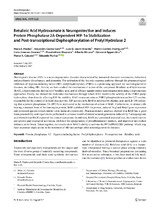Mostrar el registro sencillo del ítem
Betulinic Acid Hydroxamate is Neuroprotective and Induces Protein Phosphatase 2A-Dependent HIF-1α Stabilization and Post-transcriptional Dephosphorylation of Prolyl Hydrolase 2
| dc.contributor.author | Prados, María E. | |
| dc.contributor.author | Correa‑Sáez, Alejandro | |
| dc.contributor.author | Correa‑Sáez, Alejandro | |
| dc.contributor.author | Unciti‑Broceta, Juan D. | |
| dc.contributor.author | Garrido Rodríguez-Córdoba, Martín | |
| dc.contributor.author | Jiménez Jiménez, C. | |
| dc.contributor.author | Mazzone, Massimiliano | |
| dc.contributor.author | Minassi, Alberto | |
| dc.contributor.author | Appendino, Giovanni | |
| dc.contributor.author | Calzado Canale, Marco Antonio | |
| dc.contributor.author | Muñoz, Eduardo | |
| dc.date.accessioned | 2021-10-29T12:02:15Z | |
| dc.date.available | 2021-10-29T12:02:15Z | |
| dc.date.issued | 2021 | |
| dc.identifier.uri | http://hdl.handle.net/10396/22004 | |
| dc.description.abstract | Huntington’s disease (HD) is a neurodegenerative disorder characterized by unwanted choreatic movements, behavioral and psychiatric disturbances, and dementia. The activation of the hypoxic response pathway through the pharmacological inhibition of hypoxia-inducing factor (HIF) prolyl-hydroxylases (PHDs) is a promising approach for neurodegenerative diseases, including HD. Herein, we have studied the mechanism of action of the compound Betulinic acid hydroxamate (BAH), a hypoximimetic derivative of betulinic acid, and its efficacy against striatal neurodegeneration using complementary approaches. Firstly, we showed the molecular mechanisms through which BAH modifies the activity of the PHD2 prolyl hydroxylase, thus directly affecting HIF-1α stability. BAH treatment reduces PHD2 phosphorylation on Ser-125 residue, responsible for the control of its hydrolase activity. HIF activation by BAH is inhibited by okadaic acid and LB-100 indicating that a protein phosphatase 2A (PP2A) is implicated in the mechanism of action of BAH. Furthermore, in striatal cells bearing a mutated form of the huntingtin protein, BAH stabilized HIF-1α protein, induced Vegf and Bnip3 gene expression and protected against mitochondrial toxin-induced cytotoxicity. Pharmacokinetic analyses showed that BAH has a good brain penetrability and experiments performed in a mouse model of striatal neurodegeneration induced by 3-nitropropionic acid showed that BAH improved the clinical symptoms. In addition, BAH also prevented neuronal loss, decreased reactive astrogliosis and microglial activation, inhibited the upregulation of proinflammatory markers, and improved antioxidant defenses in the brain. Taken together, our results show BAH’s ability to activate the PP2A/PHD2/HIF pathway, which may have important implications in the treatment of HD and perhaps other neurodegenerative diseases. | es_ES |
| dc.format.mimetype | application/pdf | es_ES |
| dc.language.iso | eng | es_ES |
| dc.publisher | Springer | es_ES |
| dc.rights | https://creativecommons.org/licenses/by/4.0/ | es_ES |
| dc.source | Neurotherapeutics 18, 1849-1861 (2021) | es_ES |
| dc.subject | Protein phosphatase A2 | es_ES |
| dc.subject | Hypoxia-inducing factor | es_ES |
| dc.subject | Prolyl-hydroxylases | es_ES |
| dc.subject | Neuroprotection | es_ES |
| dc.subject | Betulinic acid | es_ES |
| dc.title | Betulinic Acid Hydroxamate is Neuroprotective and Induces Protein Phosphatase 2A-Dependent HIF-1α Stabilization and Post-transcriptional Dephosphorylation of Prolyl Hydrolase 2 | es_ES |
| dc.type | info:eu-repo/semantics/article | es_ES |
| dc.relation.publisherversion | https://doi.org/10.1007/s13311-021-01089-4 | es_ES |
| dc.relation.projectID | Instituto de Salud Carlos III. PT17/0019 | es_ES |
| dc.relation.projectID | Gobierno de España. RTC-2017–6109-1 | es_ES |
| dc.relation.projectID | Gobierno de España. FPU18/00845 | es_ES |
| dc.rights.accessRights | info:eu-repo/semantics/openAccess | es_ES |

